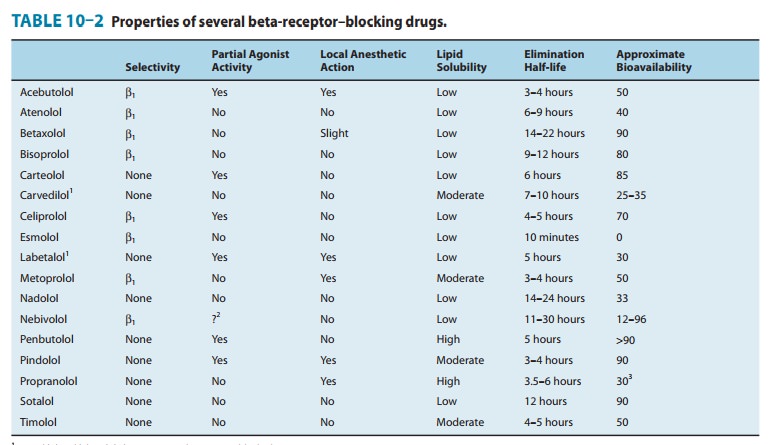Chapter: Basic & Clinical Pharmacology : Adrenoceptor Antagonist Drugs
Pharmacokinetic Properties of the Beta-Receptor Antagonists
Pharmacokinetic Properties of the
Beta-Receptor Antagonists
A. Absorption
Most
of the drugs in this class are well absorbed after oral admin-istration; peak
concentrations occur 1–3 hours after ingestion. Sustained-release preparations
of propranolol and metoprolol are available.
B. Bioavailability
Propranolol
undergoes extensive hepatic (first-pass) metabolism; its bioavailability is
relatively low (Table 10–2). The proportion of drug reaching the systemic
circulation increases as the dose is increased, suggesting that hepatic
extraction mechanisms may become saturated. A major consequence of the low
bioavailability of propranolol is that oral administration of the drug leads to
much lower drug concentrations than are achieved after intrave-nous injection
of the same dose. Because the first-pass effect varies among individuals, there
is great individual variability in the plasma concentrations achieved after
oral propranolol. For the same reason, bioavailability is limited to varying
degrees for most antagonists with the exception of betaxolol, penbutolol,
pin-dolol, and sotalol.

C. Distribution and Clearance
The
β
antagonists are rapidly distributed and have large volumes of distribution.
Propranolol and penbutolol are quite lipophilic and readily cross the
blood-brain barrier (Table 10–2). Most β antago-nists have half-lives in the range of
3–10 hours. A major exception is esmolol, which is rapidly hydrolyzed and has a
half-life of approximately 10 minutes. Propranolol and metoprolol are
exten-sively metabolized in the liver, with little unchanged drug appear-ing in
the urine. The cytochrome P450 2D6 (CYP2D6) genotype is a major determinant of
interindividual differences in metoprolol plasma clearance . Poor metabolizers
exhibit three-fold to tenfold higher plasma concentrations after administration
of metoprolol than extensive metabolizers. Atenolol, celiprolol, and pindolol
are less completely metabolized. Nadolol is excreted unchanged in the urine and
has the longest half-life of any available antagonist (up to 24 hours). The
half-life of nadolol is prolonged in renal failure. The elimination of drugs
such as propranolol may be prolonged in the presence of liver disease,
diminished hepatic blood flow, or hepatic enzyme inhibition. It is notable that
the pharmacodynamic effects of these drugs are sometimes prolonged well beyond
the time predicted from half-life data.
Related Topics